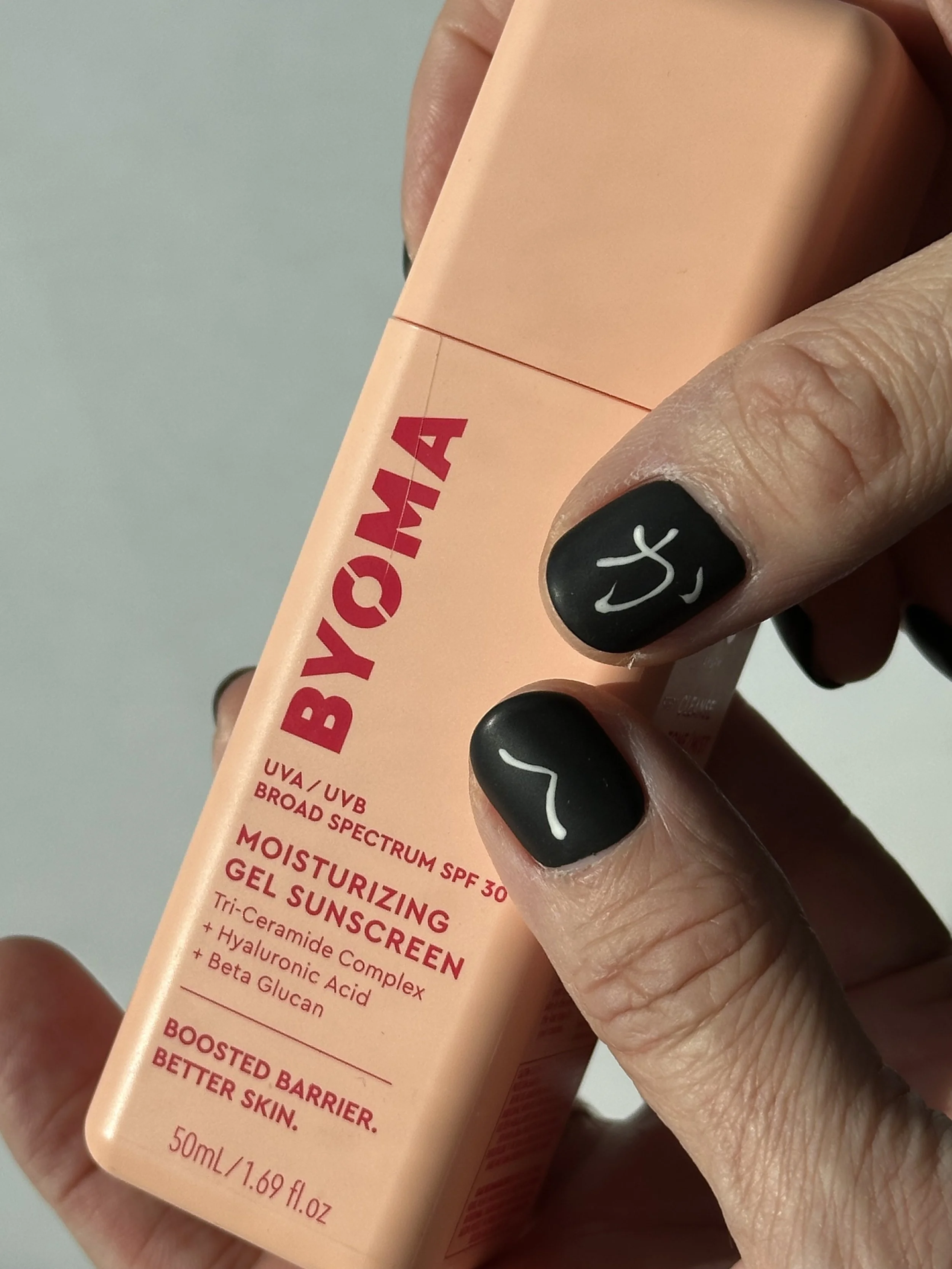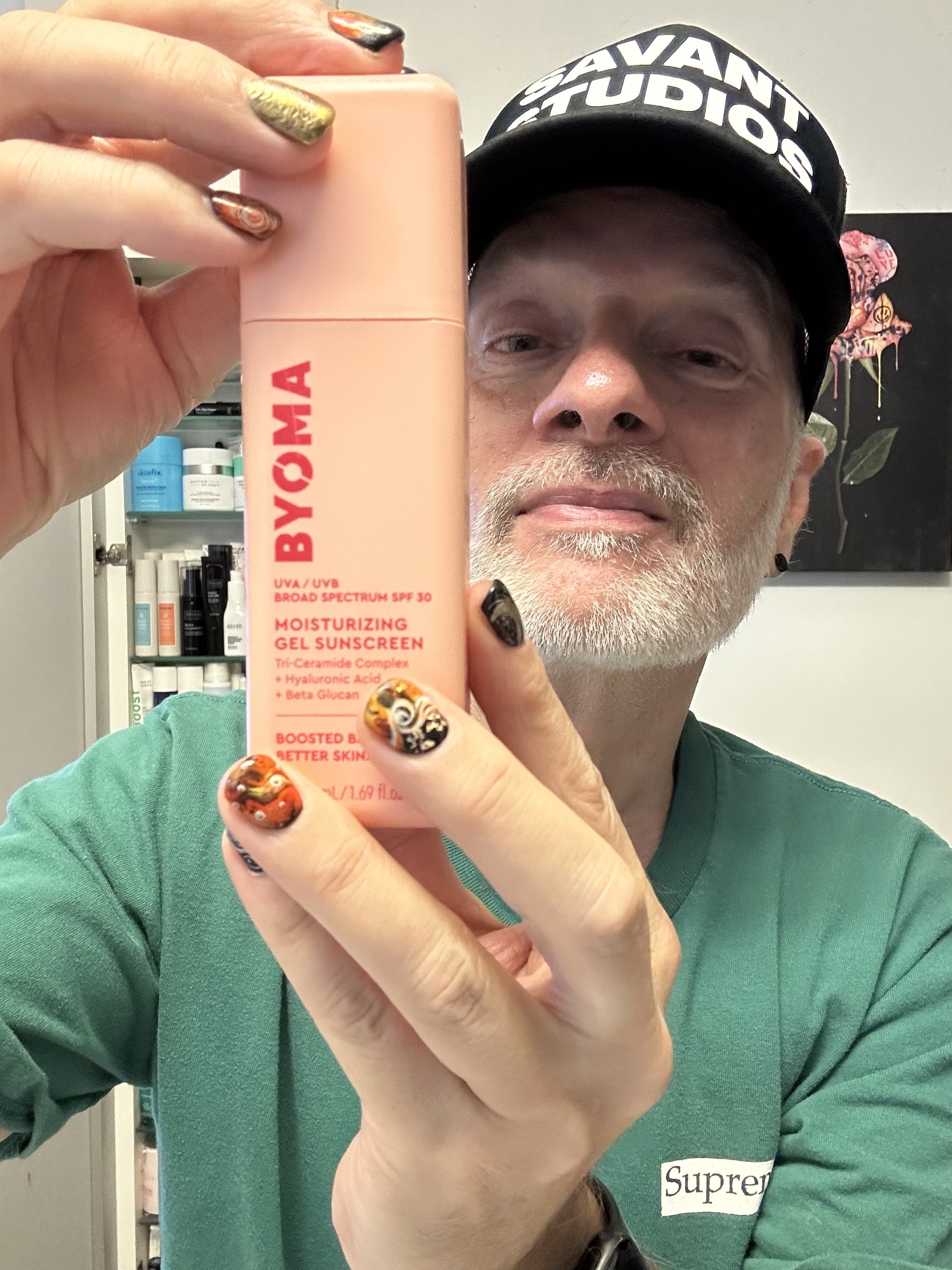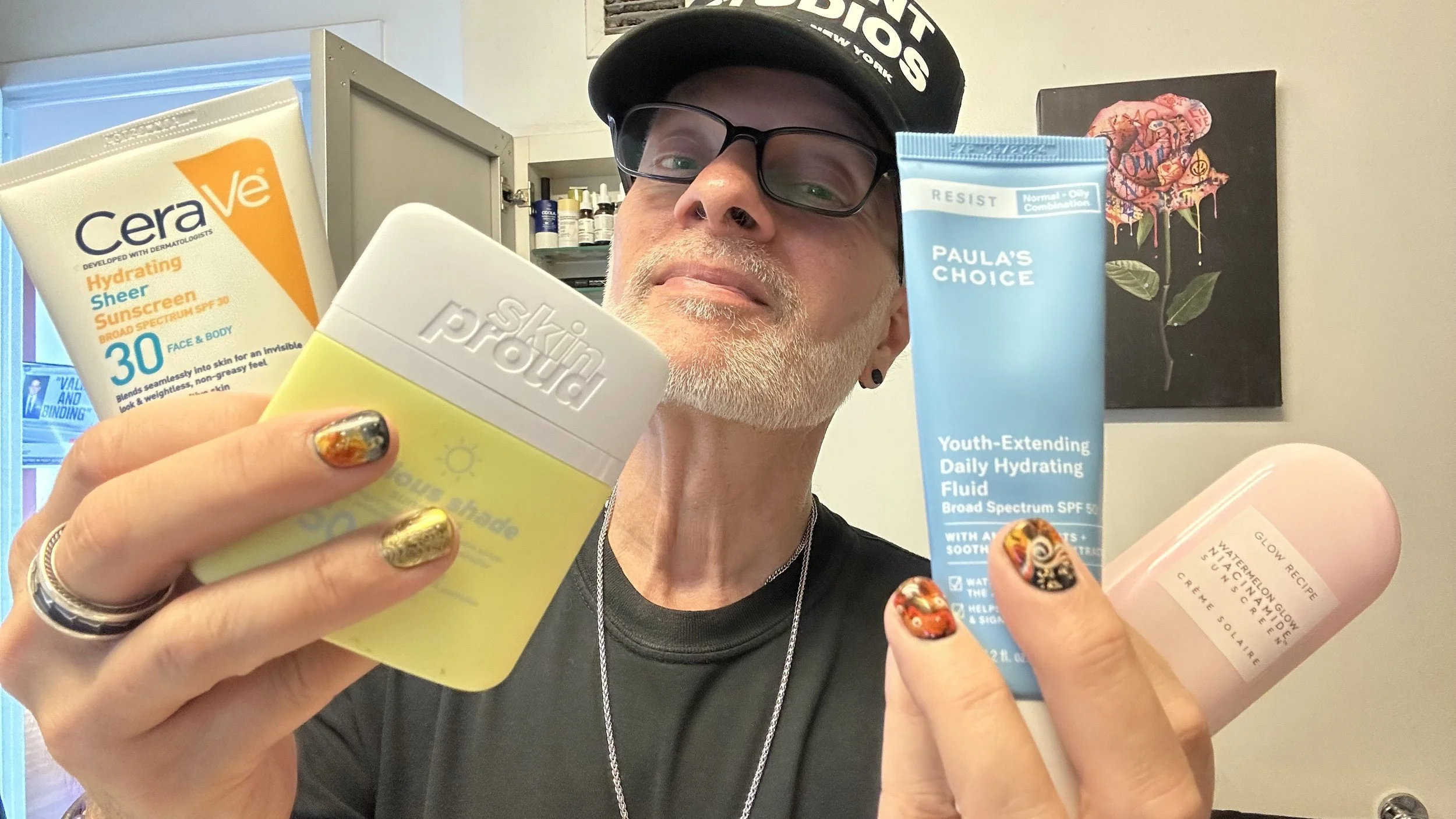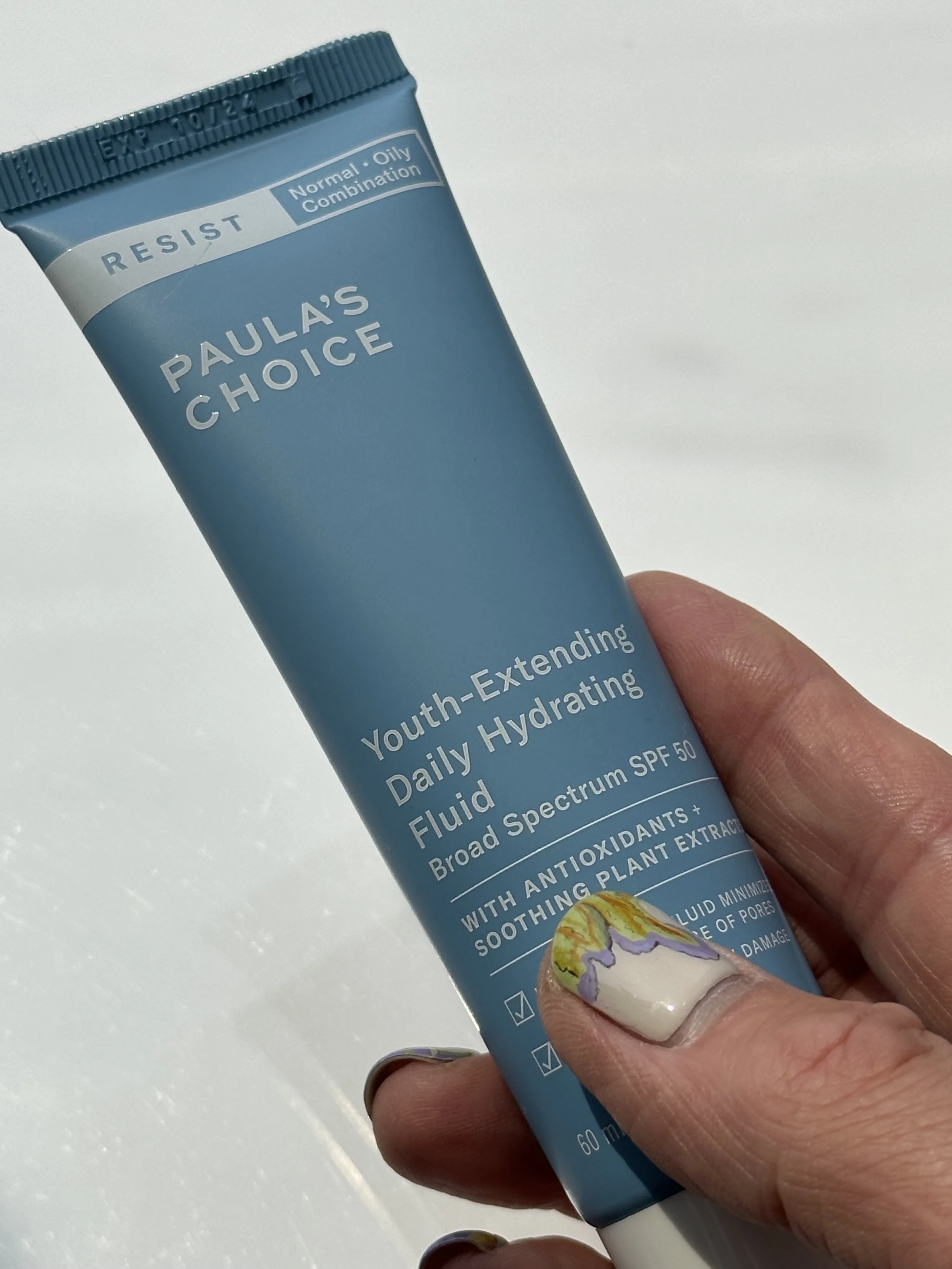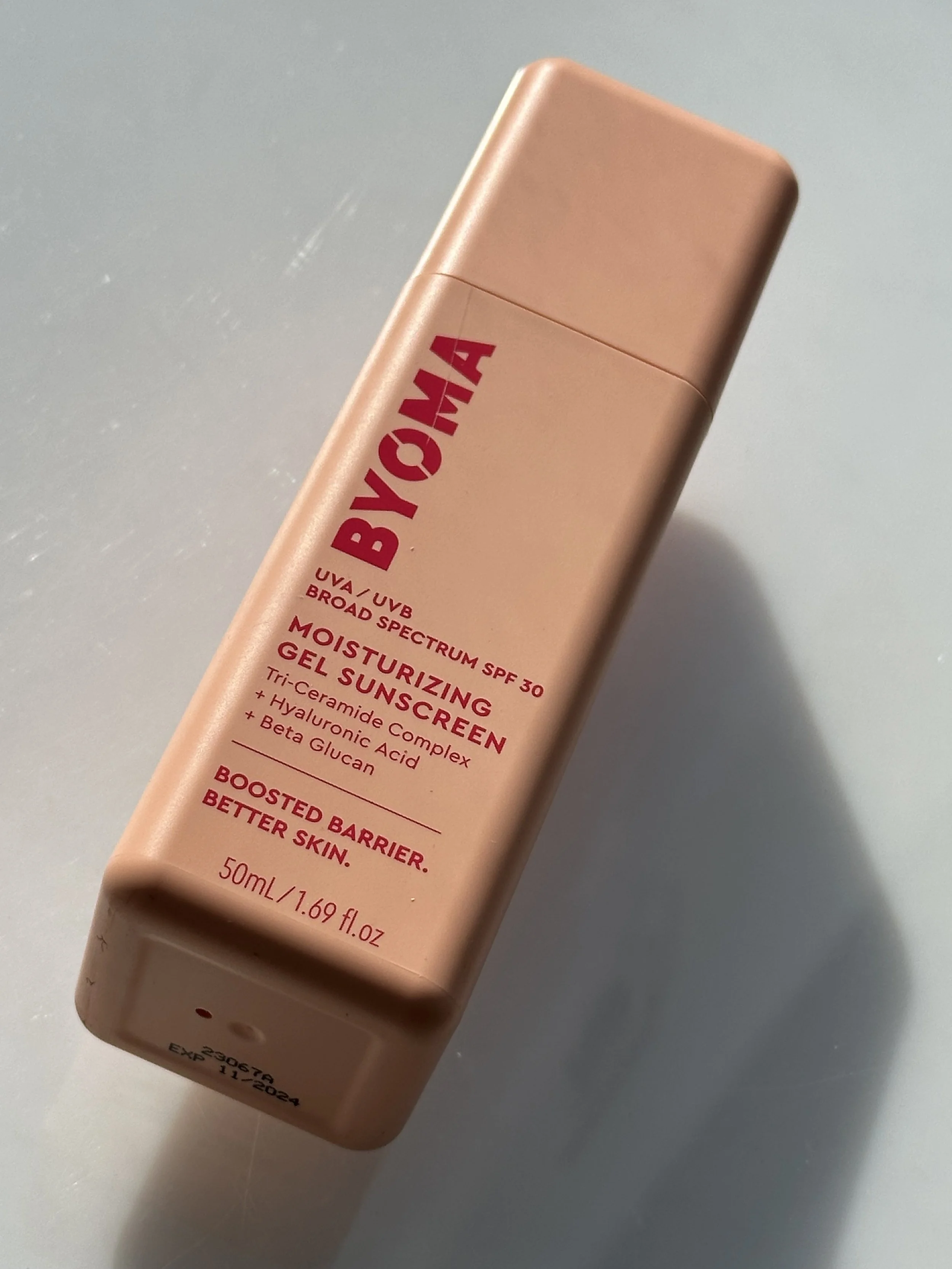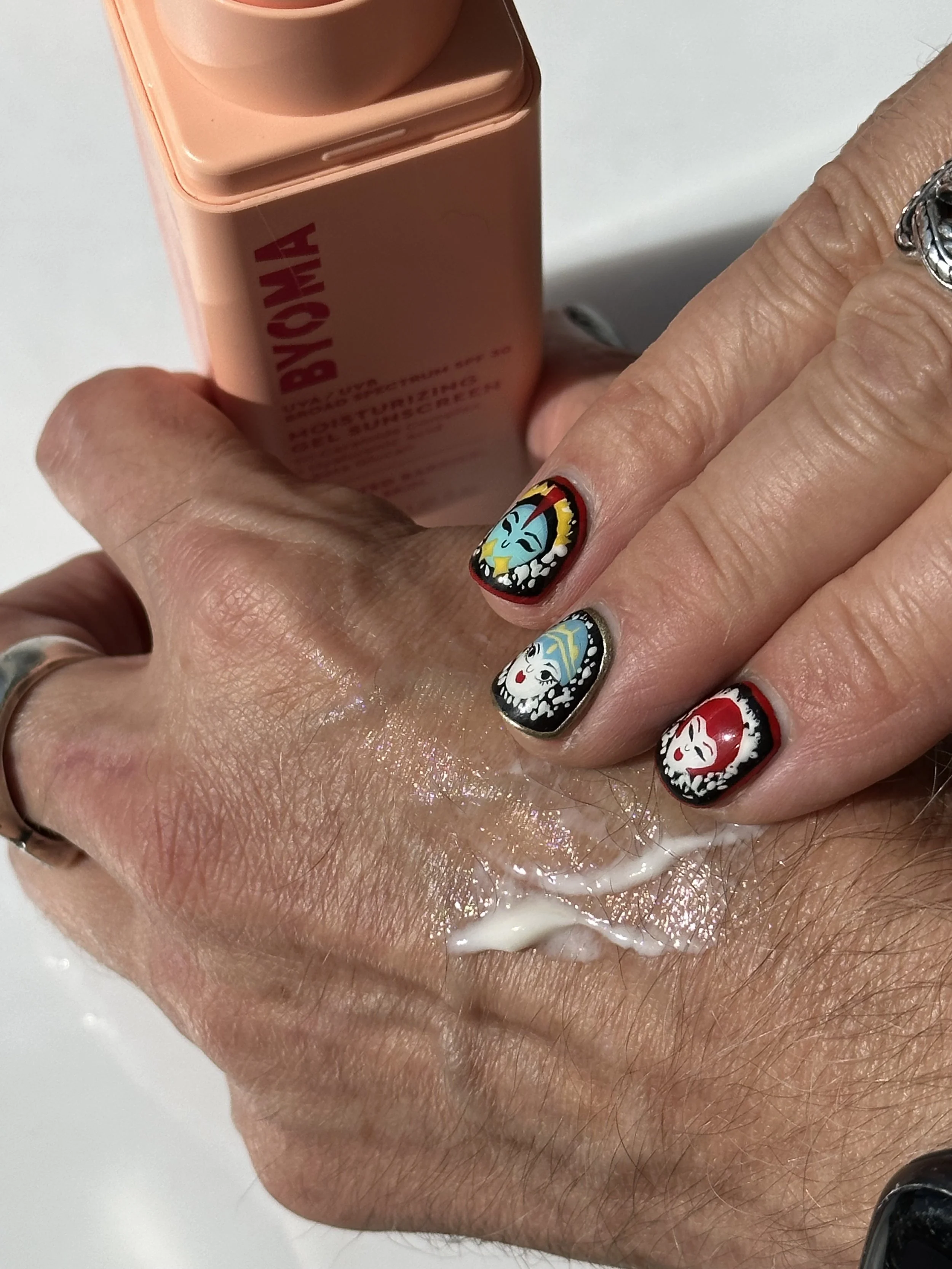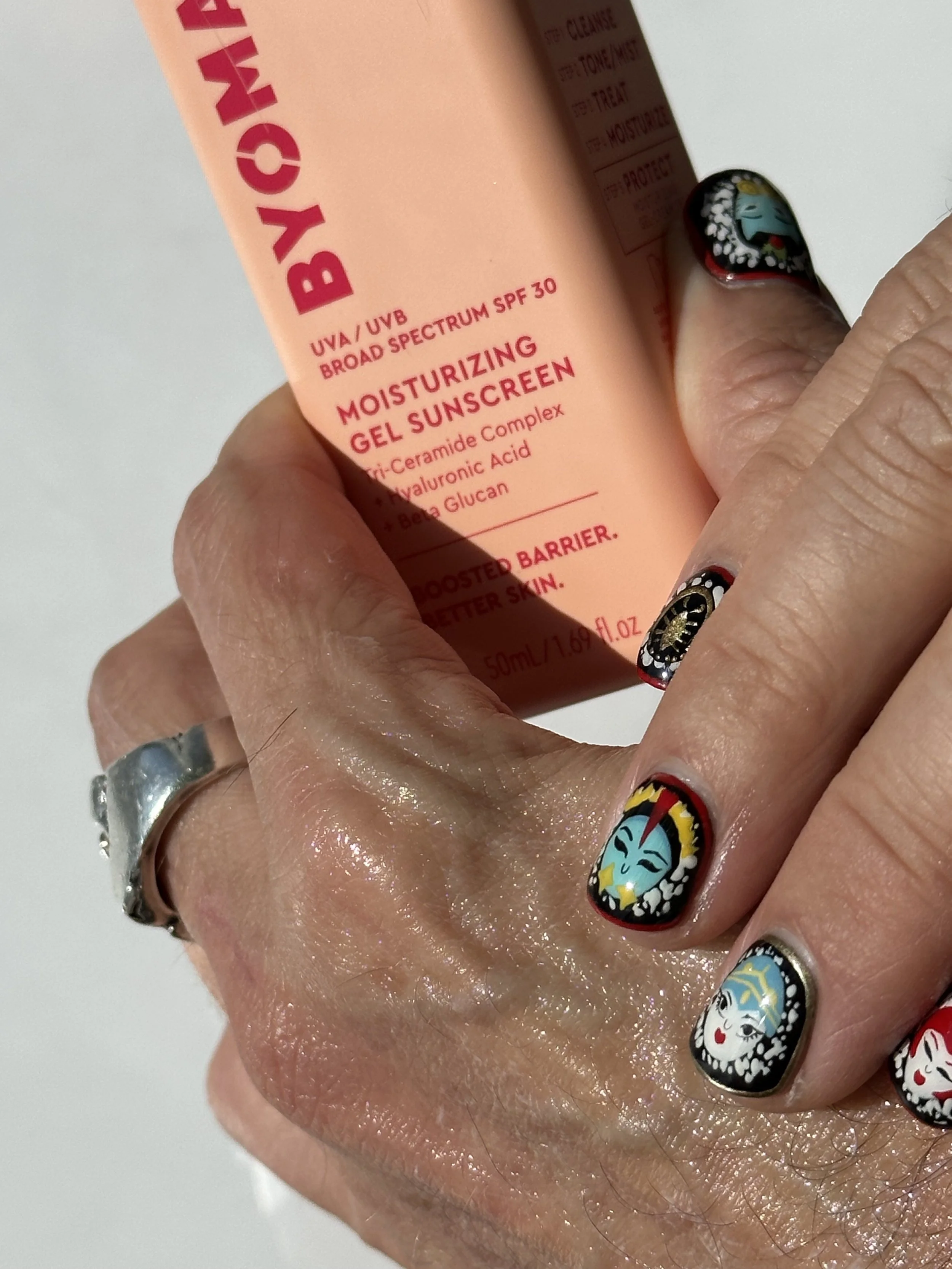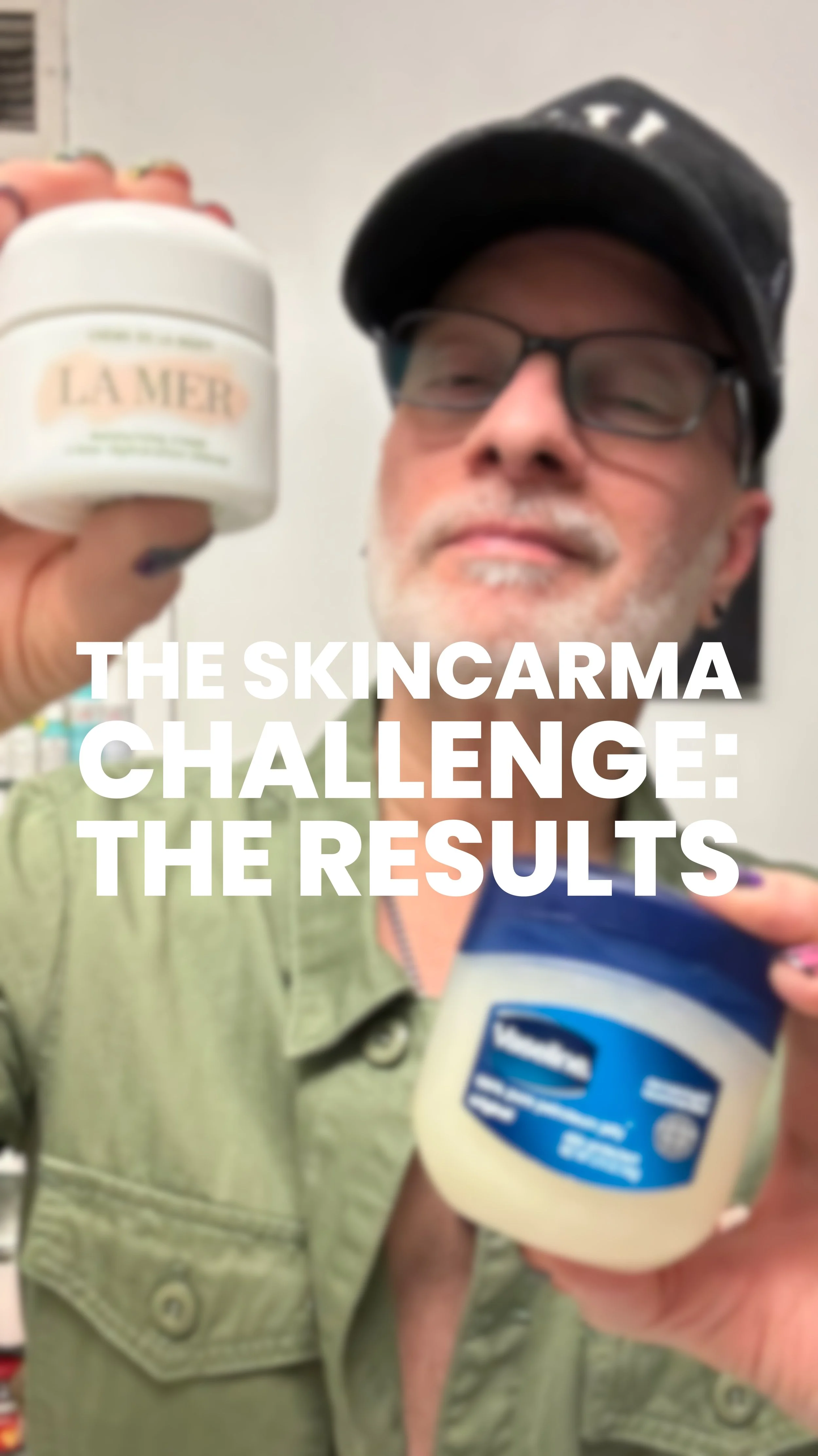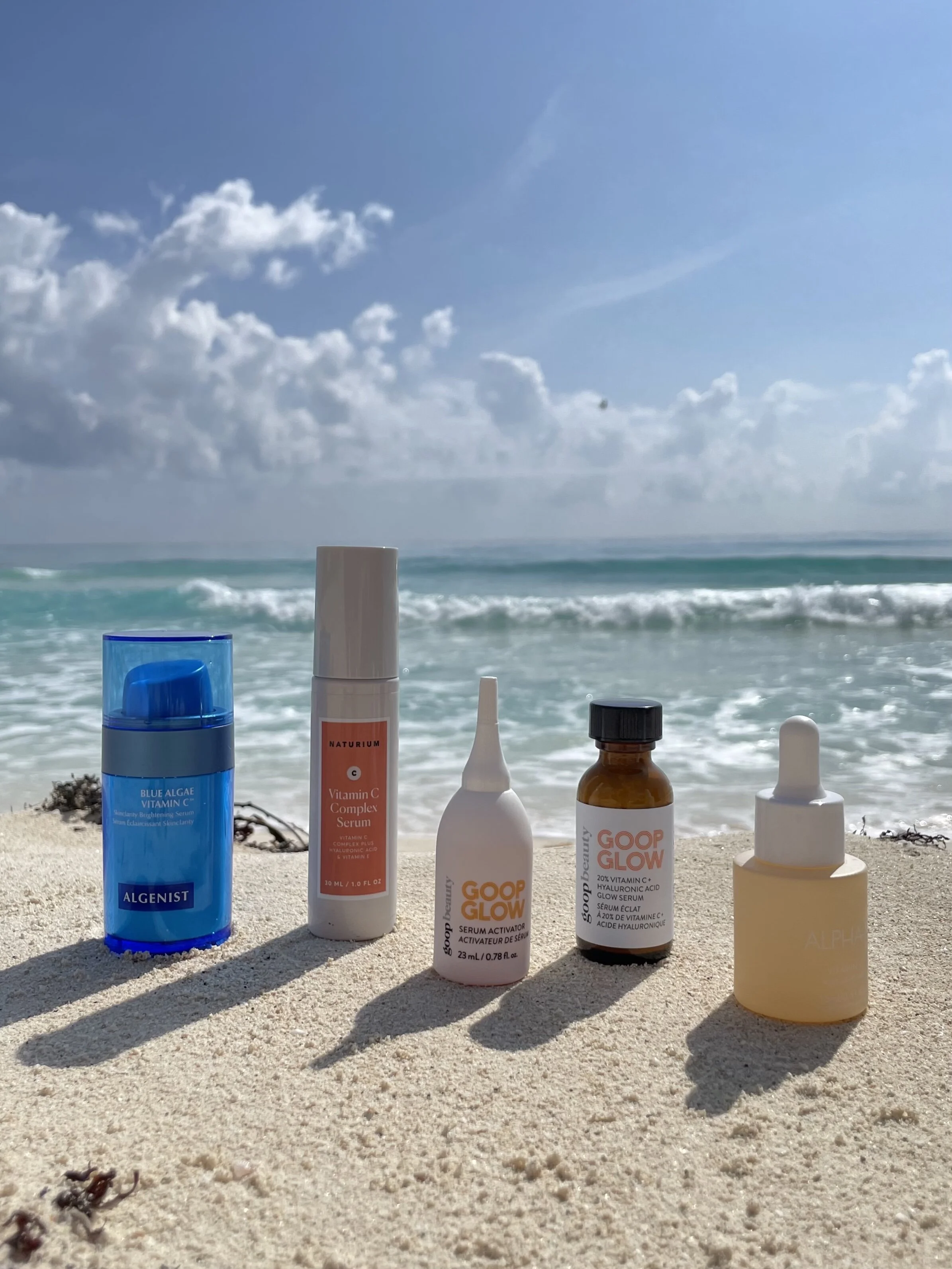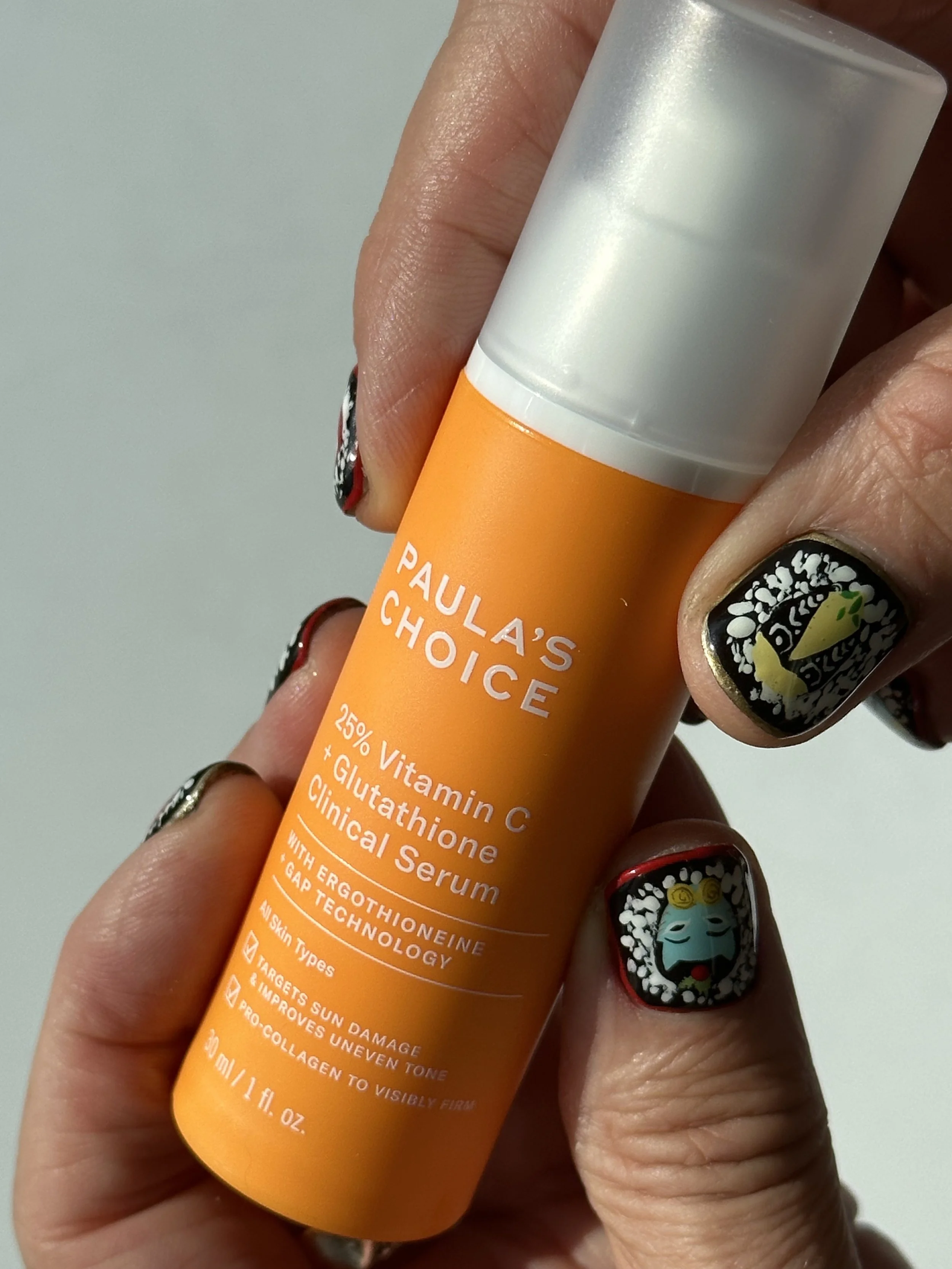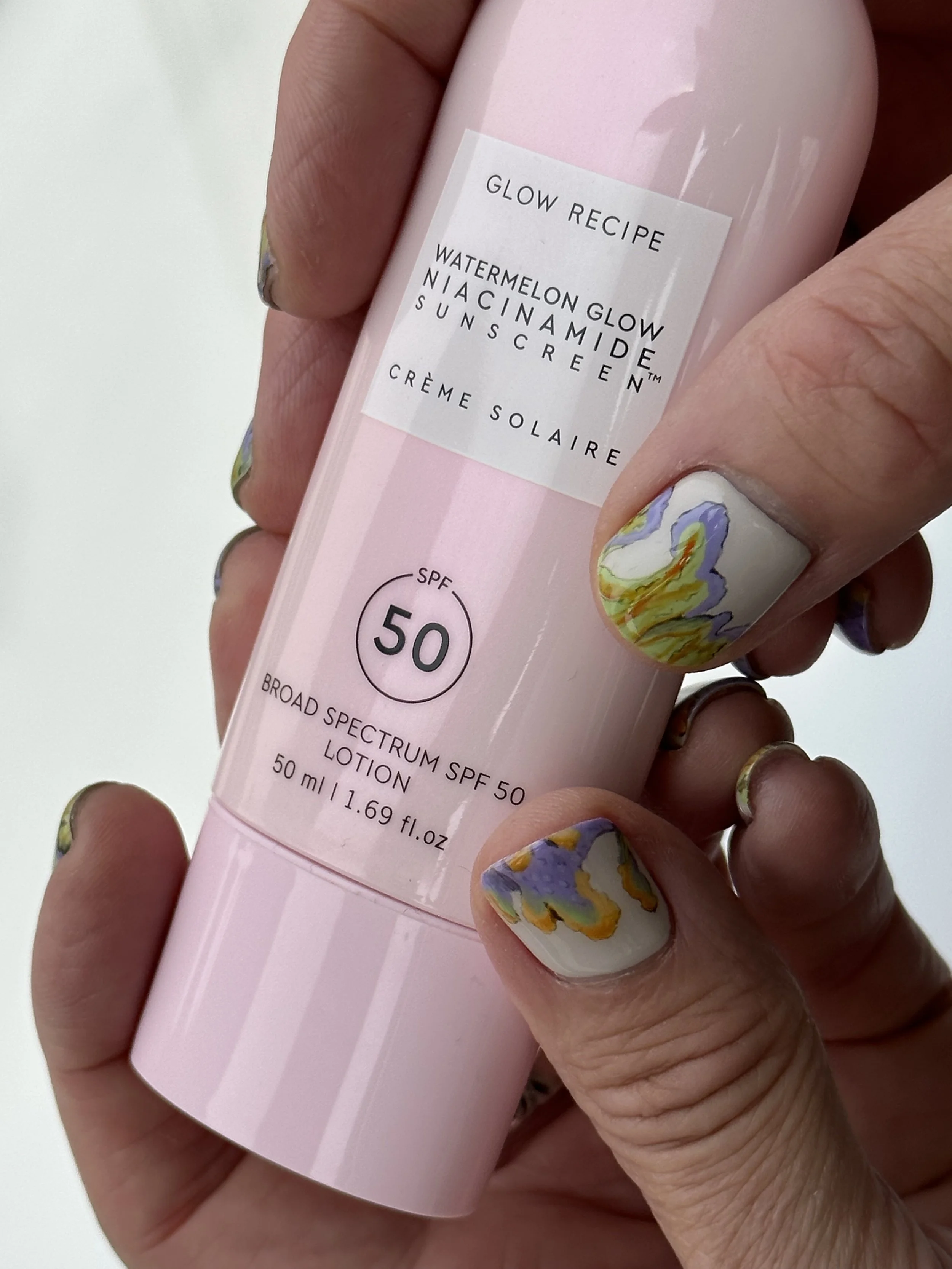PRODUCT REVIEW: BYOMA MOISTURIZING GEL CREAM SPF 30 - How do you know if your skin barrier is damaged? Can sunscreen improve the skin barrier health?
BYOMA MOISTURIZING GEL CREAM SPF 30
I really stepped up my sunscreen game this year. Don’t get me wrong, I’ve pretty much applied a facial sunscreen every day for the last 30 years or so, including in my immediate eye area.
But I’ve never had this much fun with sunscreens. And it’s not because I suddenly got weirder with my skincare obsessions.
It’s because US-based skincare brands have been pushing sunscreen innovation and adding additional benefits – including antioxidant defense and lighter textures ideal for oily skin and hot days.
For a long time, my go-to daily facial sunscreen was that iconic J-beauty one – the Skin Aqua Super Moisture Milk SPF 50. In my original review of it on the blog here, I joked that it’s so unusual it could have been made with alien technology in a lab on another planet.
That was so five years ago! Today, there are numerous sunscreens with similar textures – and much better formulas. My favorite summer sunscreen fluid this year was the Paula’s Choice Youth-Extending Daily Hydrating Fluid SPF 50 Sunscreen. I was also really into the new CeraVe Hydrating Sheer Sunscreen SPF 30 for Face and Body and Pavīse Dynamic Age Defense SPF 30 Mineral Sunscreen, made with new mineral sun filter technology invented by MIT scientists. It’s the most innovative sunscreen in decades.
My latest, end-of-summer find is the BYOMA Moisturizing Gel Cream SPF 30. As I said in my TikTok post here, the texture is so elegant I’ve had a hard time even believing it’s a sunscreen. More on this super cool new sunscreen gel below.
THE BEST SUNSCREENS FOR FACE
Funny, when it comes to product textures, I’ve generally tended to be somewhat restrained and more than a bit skeptical. In my experience with skincare marketers over my 20+ years in beauty, they often fall back on how a product feels on the skin when they’ve failed to create something truly innovative. The premise being that if a consumer loves to use it, performance won’t matter as much.
After all, enough people will believe in a product if it is marketed well. That’s the reason anyone is still spending $200 for a jar of Crème de la Mer Moisturizing Cream – little more than a $7 jar of Vaseline with seaweed in it. The first three ingredients are Seaweed Extract, Mineral Oil, and Petrolatum – yes, the lone ingredient in Vaseline. Its appeal is achieved through a massive marketing budget and the product’s luxurious texture.
In my years working in-house on Kiehl’s I was always leery of the whole sensorial thing. How a product feels and smells on the skin seemed like it should be nothing more than icing on the cake. The most important things to me have always been efficacy, performance – and whether a product is pro-skin health. Like what’s the point of skincare if it’s not advancing your skin health?
And nothing is more important to your skin health than a facial sunscreen! Until relatively recently, facial sunscreens were the least pleasurable skincare product in your skincare routine. Most facial sunscreens felt uncomfortable on the skin. Mineral sunscreens left a white cast; chemical ones smelled awful.
PRODUCT REVIEW: PAULA'S CHOICE YOUTH-EXTENDING DAILY HYDRATING FLUID SPF 50
“30 percent of women and less than 15 percent of men regularly use sunscreen on both the face and other exposed areas of skin.”
In fact, in my recent work on brand development and product packaging for the Pavīse Dynamic Age Defense SPF 30 Mineral Sunscreen, I was made aware of a consumer perception study on sunscreen usage. The study polled a range of consumers on the types of sunscreens they used, the frequency of usage – and why some participants weren’t using a daily sunscreen at all.
What?! Given the serious benefits of a daily sunscreen, including preventing photoaging and skin cancer, it seems crazy to me that so many people don’t apply sunscreen every morning of the year. According to the National Cancer Institute at the NIH, only “about 30 percent of women and less than 15 percent of men regularly use sunscreen on both the face and other exposed areas of skin.”
Why don’t people wear sunscreen? In survey after survey, consumers express their displeasure with how sunscreen looks and feels on their skin. Despite knowing the dangers of unprotected sun exposure, awful sunscreen textures deter the overwhelming majority of people from wearing a sunscreen every day.
That’s why recent texture innovation in sunscreens is so important. And why new facial sunscreens like the Paula’s Choice Youth-Extending Daily Hydrating Fluid SPF 50 Sunscreen, the CeraVe Hydrating Sheer Sunscreen SPF 30 and BYOMA’s Moisturizing Gel Cream SPF 30 are shaking up the suncare marketplace.
WOW! THE TEXTURE IS EVERYHTING. IS IT EVEN A SUNSCREEN?
Before I get into my detailed BYOMA Moisturizing Gel Cream SPF 30 product review just below, I wanted to explore some of the most frequently asked questions about skin barrier health and key actives specific to the formula…
1. How do you know if your skin barrier is damaged?
A damaged skin barrier is often the root cause of the multiple skin concerns, including redness, sensitivity, eczema and even some forms of acne. The signs of a weakened, damaged or otherwise compromised skin barrier are extensive. Among the most common signs your skin barrier is damaged are:
Dryness and Dehydration: A damaged skin barrier often leads to increased water and moisture loss. This condition is often referred to as a “leaky barrier.” It causes your skin to feel dry and dehydrated and can result in flakiness, itchiness and a rough skin texture.
Sensitivity and Irritation: A weakened skin barrier can make your skin more susceptible to external irritants, leading to redness, itching, and sensitivity to skincare products – even cleansing can become problematic.
Tightness: In some instances, a compromised skin barrier can feel tight, particularly after cleansing and the application of certain skincare products. Very dry or dehydrated skin can also feel tight and is commonly a sign of a damaged barrier.
Sensitivity to Temperature: One of the signs of a damaged barrier is increased sensitivity to temperature or climate changes. You may experience unusual discomfort or a stinging sensation when exposed to extreme temperatures.
Acne Breakouts: One of the most common signs of a weakened skin barrier is acne breakouts. In its simplest form, a damaged barrier means your skin’s natural protective barrier is disrupted or “leaky,” allowing bacteria, toxins and pollutants to penetrate more easily. As with clogged pores, the bacteria can quickly lead to an increased occurrence of acne breakouts. If you already have acne-prone skin, the situation can get noticeably worse if your barrier is compromised.
Redness or Inflammation: A damaged skin barrier can result in increased redness and inflammation, making your skin appear more irritated and prone to conditions like rosacea or eczema than balanced skin.
Explore my picks of the best sunscreens for face on the blog here.
Sources: NIH, National Library of Medicine, PubMed: Skin Barrier Function and Repair; NIH, National Library of Medicine, PubMed: Skin Barrier Abnormalities and Immune Dysfunction in Atopic Dermatitis; Cleveland Clinic: How To Tell if Your Skin Barrier Is Damaged and What To Do About It
2. Can sunscreen improve skin barrier health?
Application of a daily sunscreen is essential for maintaining skin barrier health and defending against photodamage – the main cause of skin aging. In fact, according to the Skin Cancer Foundation, “Wrinkles, fine lines and pigmentation are inevitable skin woes that often appear as we age. While we like to place blame on getting another year older, the main culprit is photoaging — damage to the skin caused by exposure to sunlight and ultraviolet (UV) light. Responsible for 90 percent of visible changes to the skin, photoaging is a direct result of cumulative sun damage you’ve been exposed to throughout your life.”
While sunscreen does not directly improve the skin barrier, it indirectly contributes to skin barrier health by preventing sunburn and reducing the risk of photodamage. By protecting the skin from excessive UV radiation, sunscreen helps to maintain the integrity of the skin barrier and prevent further damage that can weaken it.
There is simply no better way to protect and promote your skin barrier health than the application of a daily sunscreen – even on cloudy, seemingly sunless days.
Explore my picks of the best sunscreens for face on the blog here.
Sources: Skin Cancer Foundation: All About Sunscreen; American Academy of Dermatology: Sunscreen FAQs
3. Is hyaluronic acid or beta-glucan better?
Both hyaluronic acid and beta-glucan are highly pro-skin health actives with multiple benefits for your skin. While both have humectant properties that enhance the skin’s ability to hold water, each offers much more than a water-binding benefit. Hyaluronic acid is best known for its hydration and plumping effects, while beta-glucan has superb soothing and calming properties.
Naturally found in human skin, hyaluronic acid is a hydrating molecule that attracts and retains water in the skin, helping to improve skin’s hydration and plumpness. Because it is bio-mimetic, it is well-tolerated by the skin and often found in the best hydrating face creams and serums to help moisturize skin and improve its elasticity.
On the other hand, beta-glucan is a polysaccharide derived from sources like yeast, oats, barley, or mushrooms. Similar to hyaluronic acid, it has moisturizing properties and is best known for its ability to soothe and calm irritated skin. Beta-glucan has been shown to have a superb anti-inflammatory effect on the skin and to improve skin barrier function. It can help reduce redness, irritation, and even promote healing of damaged or sensitive skin.
Explore my picks of the best sunscreens for face on the blog here.
Sources: NIH, National Library of Medicine, PubMed: Advantages of Hyaluronic Acid and Its Combination with Other Ingredients; Wikipedia: Polysaccharide; Paula’s Choice: Beta-Glucan
4. What do ceramides do for skin?
A key component of your skin, ceramides play a crucial role in maintaining the health and integrity of the skin barrier. Along with cholesterol and fatty acids, these naturally occurring lipids help form a protective barrier within the skin that retains moisture, prevents water loss, and shields the skin from external irritants and pollutants.
As we age, skin loses its ability to regenerate ceramides and thus its ability to retain moisture. This progressive loss of ceramides in the skin leads to increasing dryness and a lackluster skin tone.
According to the experts on the Paula’s Choice research team, “Age and sun damage reduce the effectiveness of your skin’s natural ceramides—and can eventually deplete them, which weakens your skin’s barrier. The results of this process are drier, rougher skin, wrinkles, irritation, redness, and visible signs of dehydration. This is where skin care knowledge comes into play—because it really is possible to significantly restore what’s been diminished.”
Research has shown that the best face creams with ceramides can improve the absorption of ceramides into the skin to relieve skin conditions like dryness and promote healthy-functioning, youthful-looking skin. In fact, moisturizers, toners, and serums with ceramides can help supplement the skin’s natural ceramide production, locking in moisture and leaving your skin softer, smoother and more youthful.
Explore my picks of the best sunscreens for face on the blog here.
Sources: Medical News Today: Benefits of ceramides on skin; Healthline: Everything You Should Know About Using Ceramides; Paula’s Choice: What Are Ceramides and How Do They Work in Skin Care Products?
5. Product Review
BYOMA Moisturizing Gel Cream SPF 30 Review
I only recently discovered BYOMA, a UK-based indie skincare brand with clean, seriously pro-skin health face creams, serums, cleansers and sunscreen. The brand is focused on skin barrier health and educates heavily on the importance of fortifying the skin barrier and what they describe as “optimum barrier repair” through the constant replenishment of ceramides – the vital fatty acids found naturally in the skin.
And the BYOMA Moisturizing Gel Cream SPF 30 is one of my favorite facial sunscreen finds of 2023. It’s the only product I’ve tried from the brand and I’m excited to experience more of what BYOMA has to offer.
As I alluded to at the outset, BYOMA’s Moisturizing Gel Cream SPF 30 is so elegant and pleasurable that I almost doubt that it’s a sunscreen at all. Seriously, I wouldn’t be the least bit surprised – merely horrified – to find out that the “SPF 30” on the label was a misprint.
The texture is simply otherworldly.
As a facial sunscreen, the Moisturizing Gel Cream SPF 30 is the ideal example of the perfection of sunscreen textures in the past year or two. It’s one the latest of a class of sensorial sunscreens that glide on easily and feel great on your skin throughout the day. Among these, as I asserted earlier, are the Paula’s Choice Youth-Extending Daily Hydrating Fluid SPF 50 Sunscreen and CeraVe Hydrating Sheer Sunscreen SPF 30.
If you aren’t a fan of sunscreens and among the vast majority of people who hate how facial sunscreen feels on your skin, there’s never been a better time to start wearing sunscreen more consistently.
It’s nearly impossible to describe how unique the texture of the BYOMA Moisturizing Gel Cream SPF 30 is. It’s best characterized as a lightweight gel-lotion that melts instantly into your skin. You really have to see it to believe it. And I invite you to see it in action on my TikTok here.
The combination of texture and pro-skin health actives, including ceramides and humectants, in BYOMA’s Moisturizing Gel Cream SPF 30 makes it one of the best sunscreens for face I’ve come across in my two-decade career in beauty.
The BYOMA Moisturizing Gel Cream SPF 30 formula works to promote skin health in two ways.
First, of course, is the chemical sun filters – Avobenzone, Octylsalate and Homosalate. They combine to deliver SPF 30 protection that helps to filter out 97% of the sun’s damaging UVB rays. You may be asking, Is SPF 30 sunscreen enough? I’ve addressed this on the blog multiple times.
A sunscreen with SPF 30 blocks about 97% of UVB rays, while an SPF 50 sunscreen blocks approximately 98% of UVB rays – a mere one percent difference. What’s most important is that you find a sunscreen you love so much that you wear it consistently, even on cloudy, seemingly sunless days. Not whether it’s an SPF 30 or an SPF 50.
The second important benefit of the BYOMA Moisturizing Gel Cream SPF 30 is its high concentration of water-binding humectants in the form of Beta-Glucan and Sodium Hyaluronate – the salt form of Hyaluronic Acid that’s more compatible with human skin. And, the brand’s Tri-Ceramide Complex, which helps to replenish essential ceramides in the skin to further defend against moisture loss.
Trust me, you will love this sunscreen. There’s nothing like it out there!
6. Pros & Cons
What I like about it: The BYOMA Moisturizing Gel Cream SPF 30 is one of the best facial sunscreens I’ve come across this year – and one of my favorite sunscreen finds ever. The blend of humectants and ceramides are not exceptional. What’s exceptional is the wild gel-like texture that melts instantly into skin and feels like nothing on your face.
What I don’t like about it: I wish it had more antioxidant oomph to it.
Who it’s for: All skin types, even oily and sensitive skins.
SHOP THE BLOG: Want to try it for yourself? Purchase the BYOMA Moisturizing Gel Cream SPF 30 for $19.99 here.
The Ingredient List of the BYOMA Moisturizing Gel Cream SPF 30:
 sunsc, Homosalate sunsc, Octisalate sunsc 0 0, Glycerin
sunsc, Homosalate sunsc, Octisalate sunsc 0 0, Glycerin  sii|h 0 0, Butyloctyl Salicylate solv, Propanediol solv|h, Dimethicone emo 0 1, Beta-Glucan
sii|h 0 0, Butyloctyl Salicylate solv, Propanediol solv|h, Dimethicone emo 0 1, Beta-Glucan  so|h, Sodium Hyaluronate
so|h, Sodium Hyaluronate  sii|h 0 0, Caprylhydroxamic Acid chel, Caprylic/Capric Triglyceride emo, Ceramide NP
sii|h 0 0, Caprylhydroxamic Acid chel, Caprylic/Capric Triglyceride emo, Ceramide NP  sii, Cholesterol
sii, Cholesterol  sii|emo 0 0, Phytosphingosine
sii|emo 0 0, Phytosphingosine  sii|cci|aacne|amic, Caprylyl Glycol h|emo, Dextrin Palmitate emu|surf, Dibutyl Ethylhexanoyl Glutamide vc, Stearic Acid emo|vc 0 2-3, Oleic Acid emo|emu, Dibutyl Lauroyl Glutamide vc, Dimethicone/Vinyl Dimethicone Crosspolymer vc, Hydrogenated Lecithin
sii|cci|aacne|amic, Caprylyl Glycol h|emo, Dextrin Palmitate emu|surf, Dibutyl Ethylhexanoyl Glutamide vc, Stearic Acid emo|vc 0 2-3, Oleic Acid emo|emu, Dibutyl Lauroyl Glutamide vc, Dimethicone/Vinyl Dimethicone Crosspolymer vc, Hydrogenated Lecithin  emo|emu, Eugenia Caryophyllus (Clove) Bud Extract perf, Hydroxyacetophenone aox, Lactic Acid
emo|emu, Eugenia Caryophyllus (Clove) Bud Extract perf, Hydroxyacetophenone aox, Lactic Acid  exf|h|buff, Lecithin
exf|h|buff, Lecithin  emo|emu, Octyldodecanol emo|perf, 1,2-Hexanediol solv, Panthenol
emo|emu, Octyldodecanol emo|perf, 1,2-Hexanediol solv, Panthenol  so|h 0 0, Poly C10-30 Alkyl Acrylate vc, Pullulan, Sclerotium Gum vc, Sodium Polyacryloyldimethyl Taurate vc, Solidago Virgaurea Extract, Tocopherol
so|h 0 0, Poly C10-30 Alkyl Acrylate vc, Pullulan, Sclerotium Gum vc, Sodium Polyacryloyldimethyl Taurate vc, Solidago Virgaurea Extract, Tocopherol  aox 0-3 0-3, Xanthan Gum vc
aox 0-3 0-3, Xanthan Gum vcTHIS PAULA’S CHOICE SUNSCREEN IS EVERYTHING!
IS IT REALLY A SCAM?
Find out on my TikTok channel.
MY TOP VITAMIN C PICKS: VITAMIN C SERUMS I’M CRUSHING ON FROM ALGENIST, NATURIUM AND MORE
WATCH MY VIDEO REVIEW
THE BEST NIACINAMIDE SERUMS FOR CLOGGED PORES AND A BRIGHTER COMPLEXION
ON MY YOUTUBE CHANNEL HERE
WATCH MY VIDEO REVIEW OF
SKINCARE HACKS: GLYCOLIC ACID IS THE NATURAL DEODORANT THAT WORKS!
ON MY YOUTUBE CHANNEL HERE
WATCH MY VIDEO REVIEW OF
MY FAVORITE HUMECTANT SERUMS FROM PAULA'S CHOICE, THE INKEY LIST, GHOST DEMOCRACY AND MORE
ON MY YOUTUBE CHANNEL HERE
WATCH MY VIDEO REVIEW
COOL CLEAN FACIAL SUNSCREENS TO KEEP US SAFE AND SMILING IN THE SUN!
ON MY YOUTUBE CHANNEL HERE
WATCH MY VIDEO REVIEW
THE OPULUS BEAUTY LABS RETINOL SYSTEM – THE COOLEST RETINOL INNOVATION I’VE EVER SEEN
ON MY YOUTUBE CHANNEL HERE
WATCH MY VIDEO REVIEW
MY 2021 VITAMIN C PICKS + THE BEST VITAMIN C SERUMS TO BRIGHTEN UP THE COMPLEXION!
ON MY YOUTUBE CHANNEL HERE
WATCH MY VIDEO REVIEW OF
MY WINTER SKIN SAVIOR: SKINFIX BARRIER+ LIPID REPLENISHING SKINCARE
ON MY YOUTUBE CHANNEL HERE
WATCH MY VIDEO REVIEW
A COMPLETE K-BEAUTY ROUTINE WITH THE BEST FACIAL SKINCARE FROM PURITO, COSRX, MISSHA & MORE!
ON MY YOUTUBE CHANNEL HERE
WATCH MY VIDEO REVIEW
THE YEAR’S BEST VITAMIN C SERUMS WITH PAULA'S CHOICE, SUNDAY RILEY, THE INKEY LIST AND MORE!
ON MY YOUTUBE CHANNEL HERE
WATCH MY VIDEO REVIEW OF
A SELFCARE SUNDAY NOT FOR THE FAINT OF HEART – WITH THE PAULA’S CHOICE 25% AHA PEEL!
ON MY YOUTUBE CHANNEL HERE


